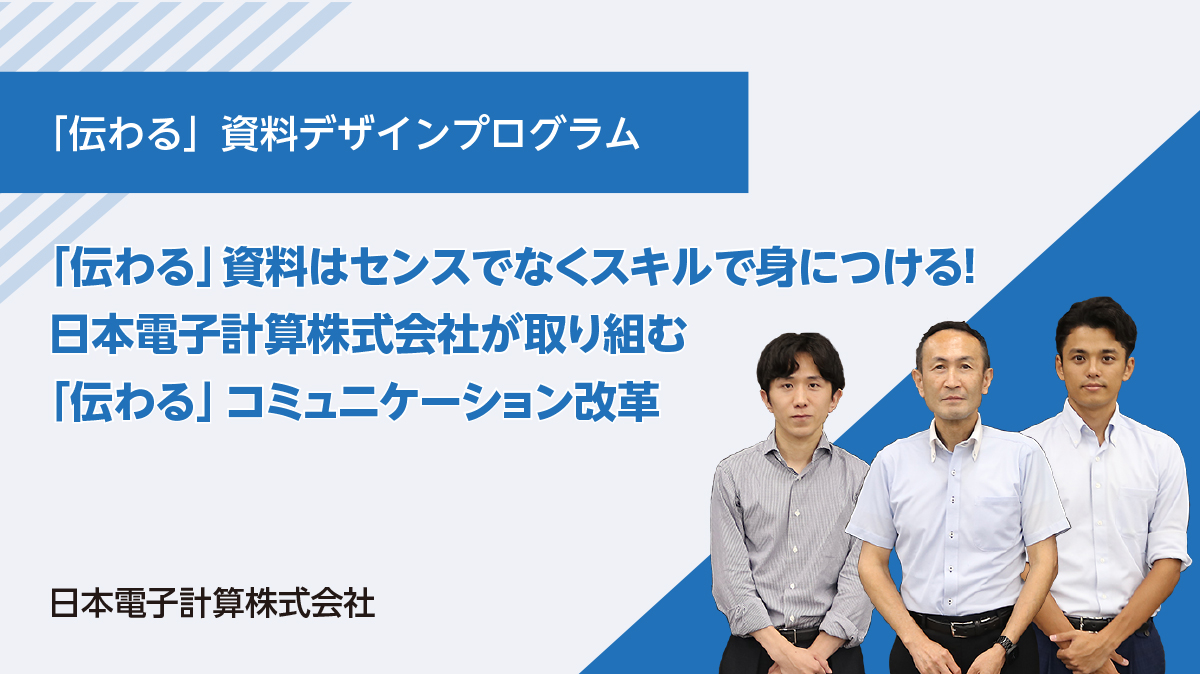
In today's world where cloud services and SaaS are becoming the foundation of business, the situations in which companies interact with customers are becoming more diverse. In the IT industry in particular, documents have become an essential "communication tool" in every phase, from proposing system implementation to subsequent operation and improvement.
The Securities Division of Japan Electronics Computer Co., Ltd. provides a comprehensive securities service for the securities industry.OmegaFS SeriesThe company proposes, operates, and provides services for the "Easy-to-Understand" document design program. Thirty members of the company's securities business division took Morisawa's "Easy-to-Understand" document design program. We spoke with Mori Hideyasu, head of the Business Planning Department, Honda Takaaki, of the Securities Services Division, and Handa Taiga, of the Securities Sales Division, about what they learned from the "Easy-to-Understand" document design program and the changes that have occurred within the company since then.
Business Introduction:With customersRespond flexibly to changes in how people connect
- Please tell us about the work you do in the Securities Business Division of Japan Electronics Computer Co., Ltd.
Director MoriThe Securities Business Division's clients include not only securities companies, but also companies that handle and directly sell investment trusts (some clients are banks). As it is a shared-use system, the logical space is securely divided for each client, and services are operated and accessed online. Each client signs up for the services they need and uses them.
Recently, there have been many entrants from other industries into the securities industry, but I believe our strength lies in our ability to utilize the knowledge and experience we have cultivated over many years to build systems that are easy to implement in the shortest possible time. Although it is a shared-use service, we are also able to flexibly customize it to meet requests for specific usage. There are a variety of use cases for securities companies, from those that conduct face-to-face transactions to those that complete transactions online, and this can sometimes be a BtoBtoC type of service.
The Securities Business Division is structured around a division of roles, with five departments: Sales, Business Planning, Development (Second General Division), Operations/Infrastructure, and Quality Control. However, this interview will be handled by three people: Honda from Development, Handa from Sales, and Mori from Planning.
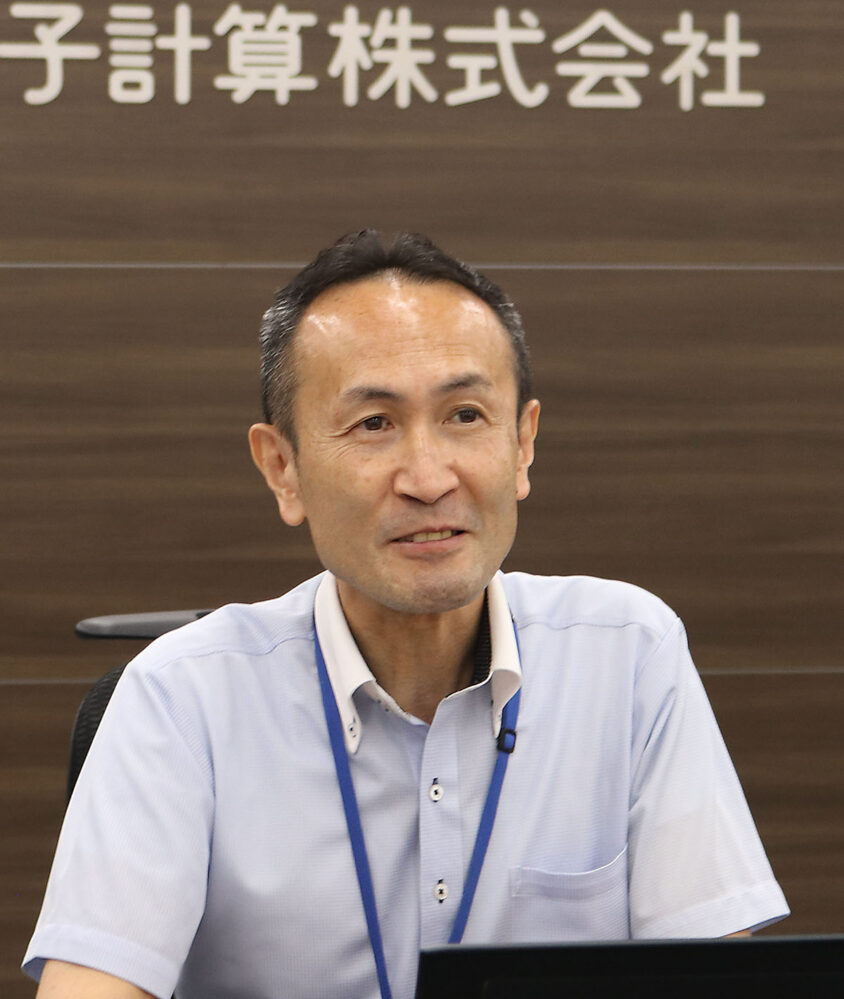
Background of the introduction:Documents that communicate effectively as a communication tool that transcends the boundaries between departmentsThe importance of
- What motivated you to take the "Communicative" Document Design Program?
Director MoriHeld on Wednesday, February 26th,Morisawa-sponsored online seminarIt all started when I attended a seminar. I was intrigued by the unexpectedness of a font manufacturer holding a seminar on such a topic.
The reason we decided to take the training was because the results of customer satisfaction surveys and other sources indicated that our proposals and explanatory materials were not reaching our customers effectively. In our securities division, all departments - sales, business planning, development, operations/infrastructure, and quality control - create and provide some kind of material for customers. Therefore, we considered training to incorporate external expertise. The fact that we could receive lectures directly from Morisawa, a font professional, was a major attraction.
- So it's not just the materials the sales department prepares when proposing a solution, but also the need to provide easy-to-understand materials to customers on a daily basis after the system goes live. Does Honda from the development department actually speak to customers in person?
Mr. HondaYes, creating and explaining materials to customers is part of my job.
We hold these explanations every other month in the form of user meetings, but if the materials are created from a development perspective, they won't get through to customers, so we try to create materials from the customer's perspective. I always feel that this is one of the most difficult aspects.
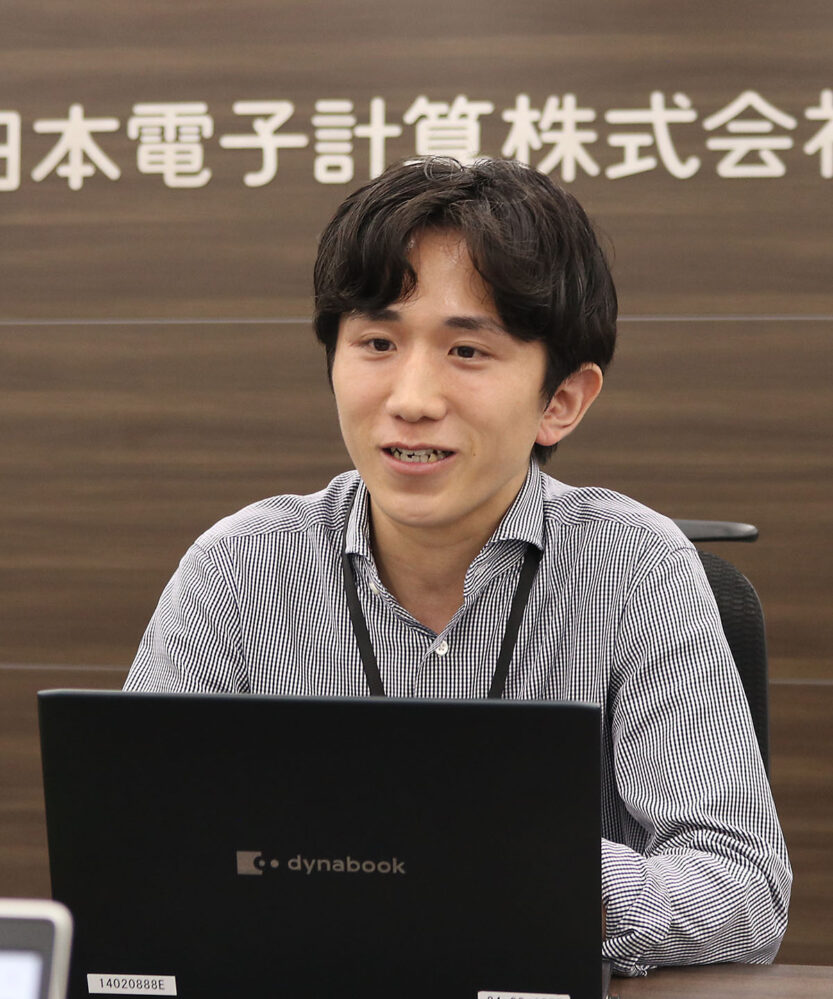
Mr. HandaSince I'm in sales, I act as the moderator at user conferences. After the conference, I follow up with each customer and my job as a salesperson is to break down the materials presented by the development and operations teams and explain them in more detail.

- So we also need to be careful about coordinating customer documents between the development and sales departments.
Training content and lessons learned: Thoroughly dissecting materials that don't communicate. Objectively looking at your company's weaknesses.
- During the training you attended, Morisawa presented a "bad example of a proposal document" and held a discussion. Did you notice anything during that time?
Mr. HandaFor each document, pairs of two people presented what was difficult to communicate, and all 15 pairs were able to point out the issues without overlapping. Even though it was only a one-page document, there were more than 15 points of discomfort. It was surprising to see how many improvements could be made and how many points needed to be communicated effectively. In business, documents must be created efficiently within a limited time frame. It's also not common to exchange opinions on documents with people from different departments, so it was refreshing to see how different departments have different perspectives.
- After that, we had a lecture for about an hour, mainly about universal design fonts and layout points, and then we actuallyPCPlease let us know if there were any memorable words or production techniques that you found during the training.
Mr. HondaI had heard that one of the production techniques is to "keep colors as low as possible," but the explanation of the perspective of the text (leaving space between lines, aligning them, etc.) made a big impression on me.
Mr. HandaI also learned the terms "jump rate" and "weight." I realized that rather than just using larger or bolder fonts, there is a "theory" to make things easier to understand. I would like to share this with my colleagues in the future.
Director MoriWe have previously conducted various training courses, such as business planning and training to develop negotiation skills, but this was the first time we had conducted production-related training like this, so I think it gave us an opportunity to think about the quality of our own productions.
Japan Electronics Computing Co., Ltd. Securities Division
"Communicative" Document Design Program
[Part 1: Group work]
Participants will be presented with "proposal materials" and will discuss them in pairs, after which they will announce any parts that they feel are "difficult to communicate." This will allow participants to gain various insights.


Various opinions were raised, such as "The speech bubbles are hard to see" and "What does this wording refer to?"
[Part 2 Lecture]
While the memory of the materials you found difficult to understand in Part 1 is still fresh, we will be teaching you the skills needed to create materials that communicate effectively, such as what points you should pay attention to in order to create materials that communicate effectively, and what UD fonts are.
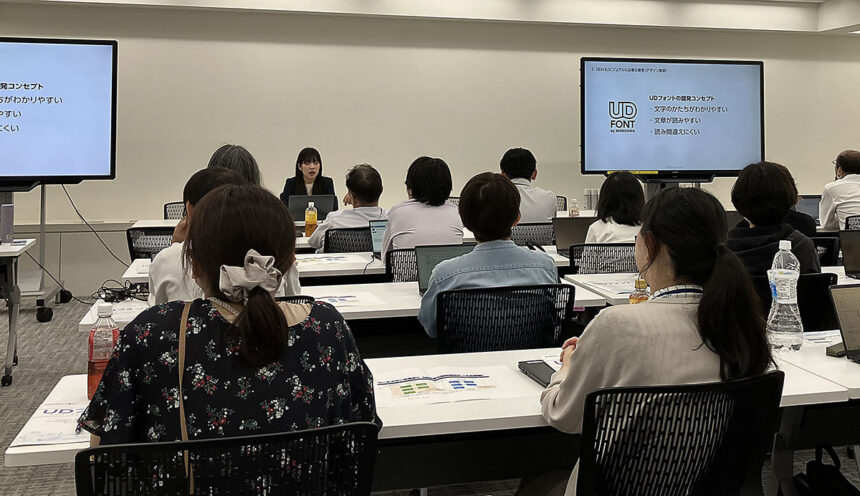
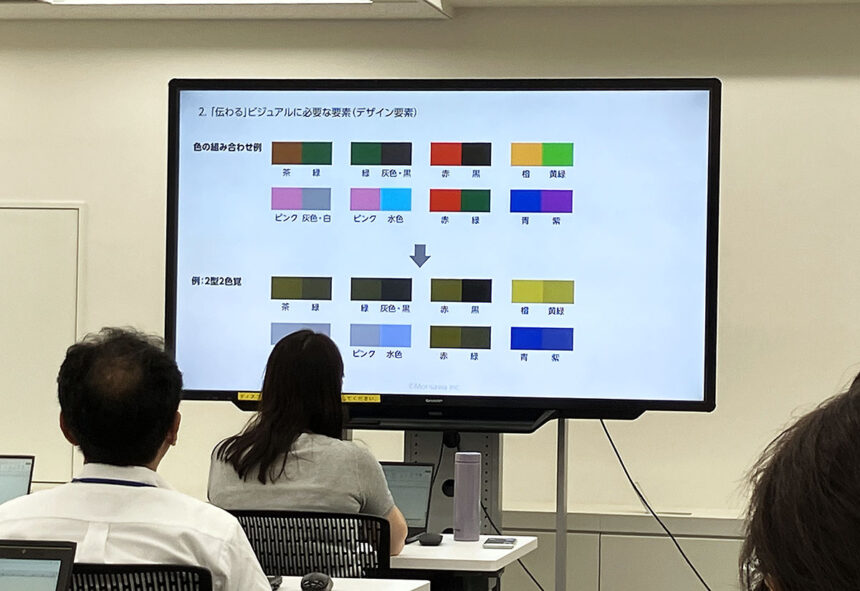
[After the class, submit the assignment as homework. The advice sheet will be returned at a later date.]
Any assignments not completed during the training will be submitted by the deadline.
After that, we will return the "advice sheet" with the corrections of the submitted assignment to you, so that you can refer back to it as a resource for improving your skills in the future.
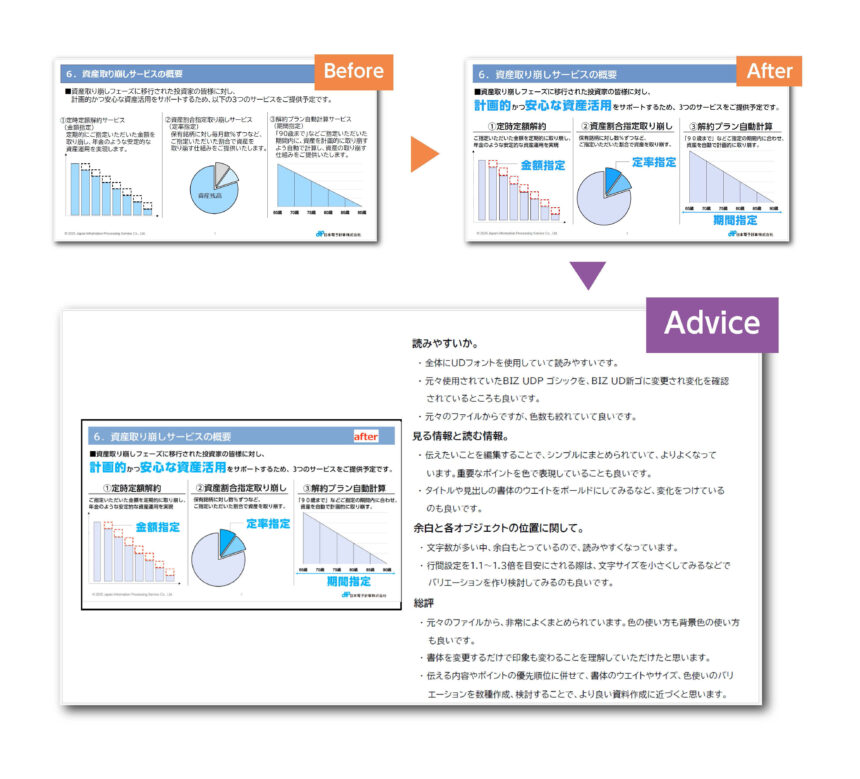
The teacher then corrected the materials on the "Advice Sheet" (bottom center).
- After the lecture, you submitted your homework assignment. Morisawa later returned the corrected advice sheet to you. What did you think about that?
Mr. HondaI made it while thinking about things that I don't usually pay attention to, and I thought I had created something that I was pretty satisfied with, but the advice sheet told me some areas to improve.
Mr. HandaI was praised for the "jump rate," "line spacing," and how I used white space more neatly. On the other hand, I hadn't paid any attention to the original material, so I realized there were many areas I could improve.
Results after training:Dialogue with customers shifts from "requirements confirmation" to "future discussion"
- After completing this training, did you create any proposal materials? Did you receive any feedback from those around you?
Mr. HondaUp until now, we have listened to customer requests, organized them, and then presented them as requirements definition documents.In the past, there were many questions about the contents of the documents, and most of the interview time was spent explaining the documents, but after the training, I feel that the number of questions about the documents themselves has decreased and the number of questions about requirement definition has increased.
Mr. Handa I later visit the customer to explain the materials created by the development department, and it becomes easier to explain the main points because the parts "written in large letters" in the materials are the key points that development wants to convey and the parts to pay attention to. I feel that the customer's understanding has improved because we can now provide more concise information.
Future outlook:A positive chain reaction that spreads from the field to create materials that "communicate"
- After attending the seminar, have you noticed any changes in the way you interact with and approach the people around you?
Mr. HondaPreviously, there was a volunteer group within the company called "PowerPoint School" to improve document creation skills. I think that people in each department wanted to deliver documents that "communicate" to customers. I felt that I wanted to share this skill with people who have the same desire but have not taken the training, and spread it further.
Mr. HandaWhen I look at the materials of people who have not taken the course, I have a lot of thoughts, so I would like to be able to give them advice.
- We hope that the quality of proposal materials within the company will improve as participants share what they have learned with those who have not taken the course and as they review proposal materials with each other before submitting them.
- Finally, is there anything else you would like us to learn from this training?
Director Mori I used to think that creating document designs was a matter of talent and aptitude, but I have come to understand very well that it is a skill.The satisfaction level for this training was very high at 97%, and we felt that it was a training session that was worth carrying out.
Mr. HondaI realized that the appearance of materials is important. If the appearance is poor, the level of understanding of the content will decrease, and I feel that it is a waste of the materials.
Mr. HandaI think the quality of the materials I've created up until now has been poor because of the way I communicated. From now on, I'd like to strive to create materials that are easy to understand so that I can communicate better with my customers.
- Thank you for taking the time out of your busy schedule to speak with us today. We look forward to seeing you continue to improve the quality of your proposals and productions.
Please take a look at the page that provides detailed information about the "Communicative" Material Design Program Training (costs, process leading up to implementation, participant feedback, etc.).
If you are interested in the training sessions for the "Communicative" Material Design Program or the UD fonts used in the training sessions, or if you are considering introducing or utilizing them, please feel free to ask us any questions using the form below.

